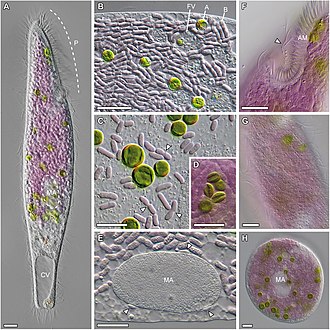Postciliodesmatophora
| Postciliodesmatophora | ||||||||||||
|---|---|---|---|---|---|---|---|---|---|---|---|---|
 Blepharisma japonicum | ||||||||||||
| Systematik | ||||||||||||
| ||||||||||||
| Wissenschaftlicher Name | ||||||||||||
| Postciliodesmatophora | ||||||||||||
| Gerassimova & Seravin, 1976 |
Die Postciliodesmatophora sind eines der beiden Untertaxa der Wimpertierchen. Sie umfassen knapp 60 Gattungen und sind damit deutlich kleiner als ihr Schwestertaxon Intramacronucleata.
Merkmale
Postciliodesmatophora sind vergleichsweise groß und üblicherweise von länglicher Gestalt. Sie sind sehr kontraktil, können sich also stark zusammenziehen. Die Alveolen der Außenschicht sind nur schwach ausgeprägt, die somatischen Kineten (die Wimpernreihen am „Mundraum“) weisen Dikinetide mit sogenannten Postciliodesmata auf (Fasern, die aus einander überlappend gestapelten postciliären Mikrotubulibändern bestehen), nach denen die Gruppe ihren Namen erhielt. Parasomalsäcke fehlen, als somatische Extrusome kommen Mucocysten, Rhabdocysten und Pigmentocysten vor. Die Strukturen des Oralbereichs sind ausgesprochen variabel.[1]
Die Zellteilung erfolgt stets isotomisch, also in zwei gleich große Tochterzellen. Der Mundapparat des Proter durchläuft vor bzw. während der Zytokinese eine Phase der Rück- und Neuentwicklung.[1]
Ökologie
Vertreter der Postciliodesmatophora sind weitverbreitet. Sie kommen sowohl sessil wie frei schwimmend vor, selten leben sie als Symbionten.[1]
Systematik

Die Gruppe wird unterteilt in zwei Untertaxa:[1]
- Karyorelictea
- Kentrophoros
- Loxodes
- Trachelocerca
- Heterotrichea
- Blepharisma
- Climacostomum
- Folliculina
- Pseudoblepharisma[2]
- Stentor
Nachweise
Fußnoten direkt hinter einer Aussage belegen diese einzelne Aussage, Fußnoten direkt hinter einem Satzzeichen den gesamten vorangehenden Satz. Fußnoten hinter einer Leerstelle beziehen sich auf den kompletten vorangegangenen Text.
- ↑ a b c d Denis H. Lynn: The Ciliated Protozoa, S. 341, ISBN 978-1-4020-8238-2, 2010
- ↑ a b NCBI: Pseudoblepharisma tenue (species)
- ↑ NCBI: Thiodictyon endosymbiont of Pseudoblepharisma tenue (species)
Auf dieser Seite verwendete Medien
Autor/Urheber: Frank Fox, Lizenz: CC BY-SA 3.0 de
Blepharisma japonicum, Heterotrichea, Ciliophora
Autor/Urheber: Sergio A. Muñoz-Gómez, Martin Kreutz, Sebastian Hess, Lizenz: CC BY-SA 4.0
Morphology of Pseudoblepharisma tenue (Heterotrichea: Blepharismidae) and its two photosynthetic endosymbionts. (A) A motile individual of P. tenue displaying a peristome (P) that occupies the first third of the cell, a posterior contractile vacuole (CV), and an elliptic macronucleus (MA) largely obscured by the photosynthetic endosymbionts. (B) Detail of P. tenue cytoplasm with purple bacteria (Ca. Thiodictyon intracellulare, B), green algae (Chlorella sp. K10; A), and food vacuoles (FV) with partially digested material. (C) Purple bacteria and green algae in a squashed ciliate. Note dividing bacteria (arrowheads). (D) Ciliate cytoplasm with small, elliptic algal cells likely originating from autospore formation. (E) Single elliptic macronucleus (MA) with peripheral micronuclei (arrowheads). (F) Peristome with adoral membranelles (AM) and opposing row of ciliated dikinetids (arrowhead). (G) Cortex of P. tenue with slightly helical rows of refractive, colorless granules (putative mucocysts). (H) Cyst-like cell of P. tenue with endosymbionts and two macronuclei (MA). Scale bars, 10 μm.

